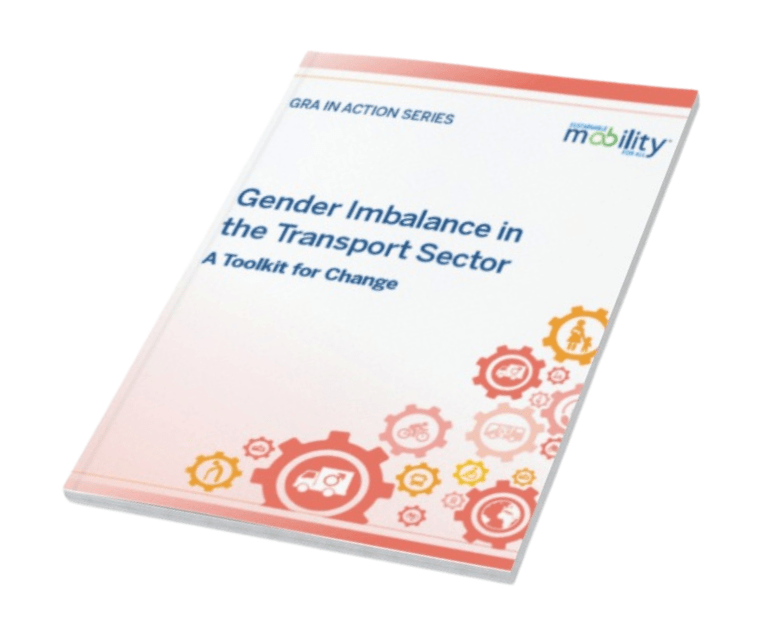A Toolkit for Change
Worldwide, the transport sector is facing a significant gender imbalance and the sector finds itself at an important moment for action. Developed by POLIS with funding from the FIA Foundation and co-authored by Heather Allen, the 'Gender imbalance in the transport sector: a toolkit for change' is the most up-to-date and comprehensive research so far on gender-balanced recruitment and retention for the transport sector, with practical tools for change.
When it comes to gender-equal employment, transport is not performing well — and that is, to put it mildly.
Women make up just 16.8% working in transport globally. This differs immensely regionally, with 29% in North America, 5.5% in the Arab States, 10% in Africa and 12.2% in Asia and the Pacific – nonetheless, the lack of women (particularly in STEM-related roles) is visible across the entire sector.
At the leadership level (in both public and private sectors) women remain a minority. Women account for only 15.5% of ministers with transport portfolios across the 27 EU Member States, and, as of February 2023, only 7 of the 64 member countries of the International Transport Forum countries have female Ministers of Transport.
Staking the case for diversity: Why is equality important?
Without addressing its gender imbalance, transport cannot, and will not, meet the significant challenges it must contend with over the next decade, and beyond.
Transport faces significant skills and labour shortages worldwide. Rail, trucking and coach sectors in particular are grappling with a crippling lack of workers, with current employees requiring upskilling and reskilling; globally, 2.6 million truck driver jobs were unfilled in 2021.
New transport technologies and mobility services are simultaneously transforming work with repercussions for women’s work in the sector, with automation, digitalisation, electrification, and the expansion of gig working platforms creating new jobs, requiring different skills and, in some cases, threatening existing functions. 'It is necessary to improve the representation of women in transport companies, promote diversity of opinion to increase the competitiveness of businesses and ensure better services,' says Evelīna Budiloviča, from the association Women in Transport.

Karen Vancluysen discusses gender equality within a wider just transition at Autonomy Paris. Credit: Autonomy Mobility World Expo 2023
Behind all this, the sector is under growing pressure to decarbonise its operations. Currently responsible for around one-fifth of the global CO2 emissions, transport is on the frontline of the race to meet climate targets. 'Sustainable and inclusive transport services cannot be delivered without a more diverse workforce,' says Karen Vancluysen, Secretary General of POLIS.
This sentiment is echoed across the pond. 'If we truly want to design more equitable transportation systems that serve all who use it, it is vital we increase gender equity in the transportation workforce, particularly at the decision-making levels,' says Laura Chase, CEO at ITS America.
The need for action is recognised
From the IRU’s driver shortage report to World Bank’s The ABCs of the Role of Public Transport in Women’s Economic Empowerment, we are seeing growing calls for action. Aviation, maritime, automotive, shared mobility, and public transport; leading transport bodies are placing gender higher on the agenda than ever before.
Meanwhile, the European Commission is increasingly placing action on gender equity in transport front and centre of the European Year of Skills. Indeed, their Ambassadors for the #DiversityInTransport network seek to promote diversity, equality and inclusion in all its forms within the EU transport sector. 'The Network received a lot of enthusiasm and now has a total of 70 Ambassadors across 18 different countries in the EU,' says Lucia Schlemmer, Panteia, which is leading this initiative.
From ambition to action, creating tangible change?
However, the last decade has seen neither the scale nor speed of progress required, and there has been little significant improvement in the situation on the ground.
Indeed, between 2013 and 2023, there was less than 3% improvement in the volume of women employed in the sector. The need for immediate and transformative change can no longer be ignored.

The SUM4All Toolkit. Credit: SUM4All project
The 'Toolkit for Gender Equitable Employment in Transport', developed by POLIS with funding from the FIA Foundation and co-authored by Heather Allen, addresses this challenge head-on with practical tools for change. 'Failing to capitalise on the extraordinary talents and abilities of the many women at work at all levels in the transport sector is not only a terrible waste of talent and resource but also potentially undermines wider work on sustainability,' said Sheila Watson, Deputy Director of the FIA Foundation.
Informed by extensive primary and secondary research conducted over a year, the toolkit surveys the current state of the transport workforce, and the key changes we have witnessed across the last decade and identifies the key barriers which are obstructing progress.
Put yourself in an employer’s shoes. What information and data would you need to understand how and why gender imbalance persists? How can you engage leadership and executives? What does flexible working look like in practice, and how can it be configured to directly address gendered employment needs? How can partnerships be kick-started and scaled to support women and girls in STEM roles?
The toolkit is a practical resource for reflecting on an organisation’s current approach to equity and its potential for advancement. It calls on readers to examine their existing recruitment procedures, workplace policies, processes, and career advancement opportunities.
The findings
The research unveiled that despite progress in global and national policy arenas, women working across the transport sector continue to face multiple impediments to entering, remaining, and advancing their careers. While there are regional and modal variations, the toolkit identifies 5 key barriers to women’s ability to enter and flourish in the transport sector and 5 entry points for action. 'Our study shows that currently despite many policies being in place it remains predominantly masculine,' said the toolkit’s co-author, Heather Allen, Independent Gender and Sustainable Transport expert.

Launch of the Toolkit. Credit: FIA Foundation
Gendered stereotyping, discriminatory and unsafe workplace cultures, lack of flexible working and childcare provisions and ‘invisible’ glass ceilings are constraining progress towards a more gender-balanced workforce, with detrimental impacts on those women already working there.
Five key barriers
1. Gendered stereotyping
2. Discriminatory workplace culture
3. Lack of flexible working/childcare provision
4. Glass ceiling and low chances for career development
5. Lack of all forms of diversity at all levels
Although international and national equal opportunities and anti-discrimination policy frameworks lay the foundations for change, decision-makers in the transport sector cannot rely solely on these to generate the transformative shifts necessary at the rate required. 'If we can truly turn the dial on the gender balance in the transport sector, we will not only unlock commercial success, but we'll also improve the experience for customers switching to sustainable travel,' says Rachel Geliamassi, Managing Director, Stagecoach West, who’s an approach to rostering is used as a key case study in the toolkit — 'In Stagecoach, this toolkit will help to unlock this well overdue gender diversity including recruitment and talent development initiatives focused on equity.'
Targeted, effective action demands positive action at the organisational level, and there are many out there, which have proved incredibly successful; from innovative approaches to flexible working, new ways of collecting employee satisfaction data, partnerships between universities and operators, and platforms for addressing gender bias in recruitment.
Five key actions
1. Get recruitment right to eradicate stereotyping jobs
2. Implement inclusive workspaces
3. Provide flexible working for childcare
4. Leverage leadership potential
5. Deliver diversity beyond gender balance
The importance of leadership
Securing more women in leadership is essential for fostering diversity throughout an organisation, and in those which have succeeded in doing so, changes to entrenched cultures, recruitment and procurement practices often followed. 'Female leaders in our sector do not find themselves on the same footing as men,' Marta Serrano, EMT Valencia’s first female CEO, told the study authors.

Isobel Duxfield discusses the findings of the SUM4All Toolkit. Credit: International Transport Forum
There were indications from some that women are making headway in transport leadership. Indeed, almost 90% stated there are leadership and senior positions in their organisations currently (or in the recent past) held by women. However, while this progress is to be celebrated, it discloses the insufficient scale of advance. In a third of instances, no progress has been made over the last decade.
At the same time, as new technologies create opportunities for new and innovative mobility services, the lack of women in entrepreneurial positions is clear. 'Most new urban mobility solutions — electric kickscooters, autonomous vehicles, on-demand shuttle buses, urban air services — appeal mostly to young professional men with an above average income and education level. It is a systemic bias that we have to overcome if we want to create more diverse mobility solutions that will serve everybody,' says Sandra Phillips, Shared Mobility Architect, and founder of EmpowerWISM — an award that recognises and supports female entrepreneurs in transportation.
Diversity does not just mean gender balance
Critically, this study pushed conversations around diversity beyond just gender balance. There is clear recognition of the need for a more diverse workforce, yet there remains less understanding of the ways gender equity and other axes of identity intersect, and the impacts on everyday workplace behaviours.
This is an area that the sector must address more comprehensively. According to Mckinsey’s report this year, only a quarter of C-suite leaders are women, yet just 1/20 is a woman of colour, meanwhile, there has been clear recognition of the racial disparities in maternity leave provisions in the USA and UK. In many cases, recent reviews of diversity policies and internal practices were prompted by race-equal movements such as Black Lives Matter, which exposed the often 'invisible', passive or latent experiences of racism and the interconnections with gender inequality.
Do not reinvent the wheel!
The toolkit provides in-depth case studies on how actions can be initiated, the technologies on hand to assist, partnerships which can be created, and other key information for practitioners seeking hands-on solutions. This is not to say achieving gender equality will be easy, not success immediately, but action must start now!
Click here to read the article in its original format.
About the author:
Isobel Duxfield is Communications and Membership Manager at POLIS. She completed her MPhil in Gender Studies at the University of Cambridge, where she researched gender and cycling. Isobel manages the SUM4All project and has published academic work on gender and active mobility, and domestic violence prevention.
